Steve Vai - His First 30 Years | The Documentary
Page 4: David Lee Roth - Ibanez JEM - Whitesnake
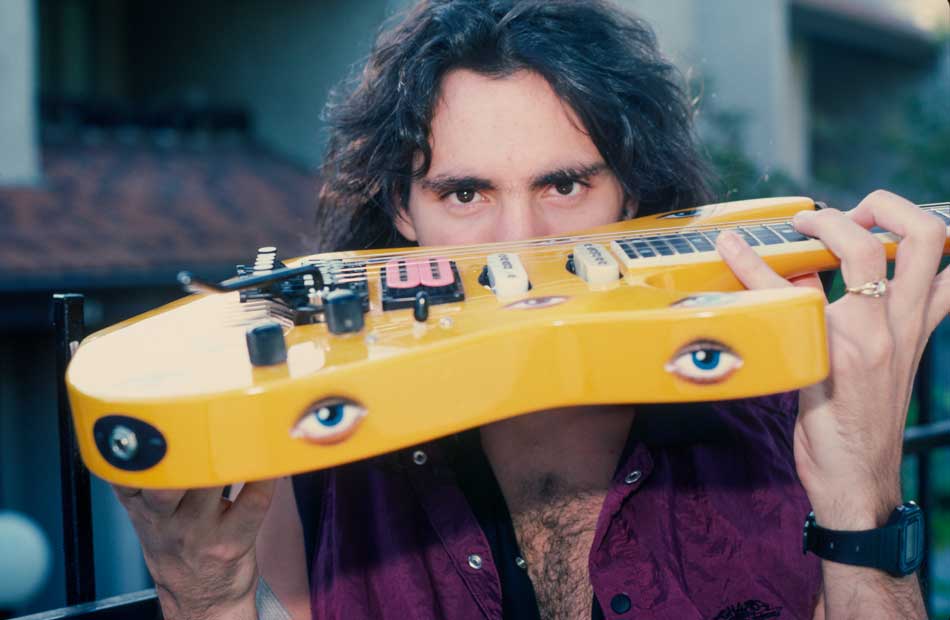
David Lee Roth Band:
During the same time that Crossroads was being filmed (spring/summer 1985), Vai was preparing for an Alcatrazz tour. He was in the shower when the phone rang one day. Steve answered it, dripping with suds, and heard the lively caller say, “Hey, this is David Lee Roth. I’m making a movie, and I’m looking for some music. Would you like to come down and write a song for the movie?”
Vai said sure but commented that he had to do a short tour with Alcatrazz first. Vai then fulfilled his obligations with Alcatrazz and was ready to move on to the most coveted guitar spot at the time in all of rock’n’roll.
Diamond David Lee Roth had left Van
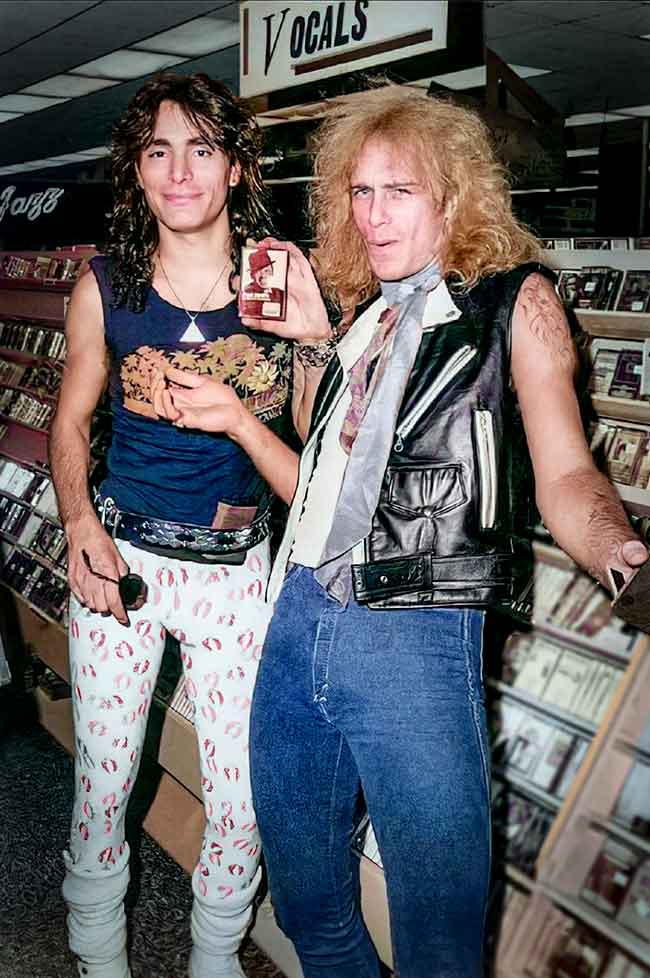
“Two wild and crazy guys”
Halen for multiple reasons in 1985. One of them being his pursuit to become a legit actor via him producing his movie Crazy From the Heat. Working with Roth, his creative partner and manager Pete Angelus planned to direct the movie. (Angelus and Roth were also known as The Fabulous Picasso Brothers.) Dave had financing from CBS Films, a script, costumes, locations, and now he needed a band to make the soundtrack. The first person in was nimble-fingered bassist Billy Sheehan who Roth knew from when Sheehan’s band Talas opened for Van Halen five years earlier.
After consulting with Ted Templeman, longtime Van Halen producer, who’d produce the forthcoming Crazy from the Heat soundtrack album, Roth offered the guitar gig to Billy Idol’s axman Steve Stevens. But Stevens told Roth that because of his musical commitments to Idol, he couldn’t work on the project.
This was when Sheehan and Templeman suggested Vai. Sheehan knew Vai from being on the same label, Relativity. Templeman’s connection was through Vai’s guitar tech Elwood Francis. Elwood and Templeman were with Aerosmith during the mix-down of their album Done with Mirrors. Elwood popped in Vai’s solo tape during a session, and Aerosmith and Templeman were all impressed. Knowing that Roth was looking for a guitar player, Templeman shipped the tape off to Diamond Dave.
One of Steve Vai’s drumming buddies, Chris Frasier, was the first to fill the drummer role, but for unknown reasons, Roth wanted to find someone else. Sheehan and Vai were instructed to locate another drummer, and they brought back big band skin basher Gregg Bissonette.
The three sequestered themselves in the basement of Roth’s mansion and jammed on new song ideas while Roth and Angelus were upstairs in pre-production for the doomed movie.
In early November 1985, just days before they were set to begin shooting, the phone rang in their studio office. It was Roth’s attorneys calling to deliver some terrible news. CBS, facing serious financial woes, had shuttered its film division, leaving Angelus and Roth without a means to make their movie. Angelus says that after the initial shock dissipated, they began discussing their options, asking each other: Apart from litigation against CBS for breach of contract, what’s our next step?
Sheehan recalled telling Roth that day, “‘The hell with it. We’ve got a band. We’ve got songs. Let’s go out and tour!’ Not that he already didn’t think that, and not that he needed any encouragement from me, but I just remember thinking, I’m ready to play.”
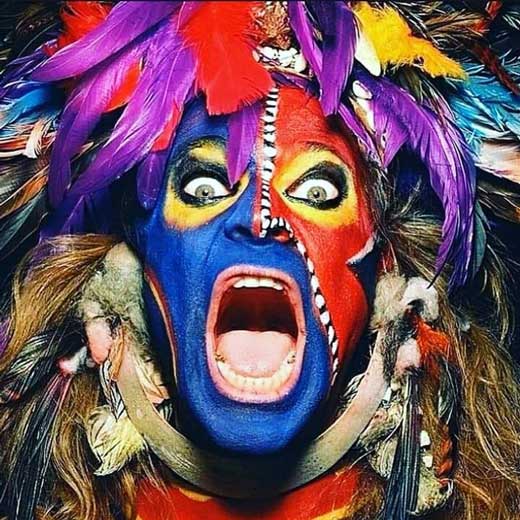
Eat ‘Em and Smile:
In late November, just days after the movie was put on hold, the four musicians set forth to record what would become the landmark album Eat ‘Em and Smile. The album would be released the following year (July 1986) to critical and commercial success selling millions of copies.
The tour that followed was a huge success. From August 1986 until February 1987, the David Lee Roth concerts sold out many dates and played to packed arenas all over North America. Steve Vai had proven, not that he cared, that he was a suitable replacement for Eddie Van Halen. But by the end of the tour, Vai knew he would not stay in the group for much longer.
Ibanez JEM:
Until 1987, Vai was a free agent in the world of guitar endorsements, which led to heavy courting from all the leading guitar companies. At this time, Steve played axes handbuilt by Performance Guitar, Charvel, and Jackson. He enlisted his childhood friend and fellow Long Island native Joe Despagni to assemble, modify and rout Steve’s custom guitars. Joe and others would assemble parts into a customized super-strat for Steve, and then Despagni created Vai’s infamous Flame guitar and was the first person to work out Vai’s idea of a monkey grip on a guitar.
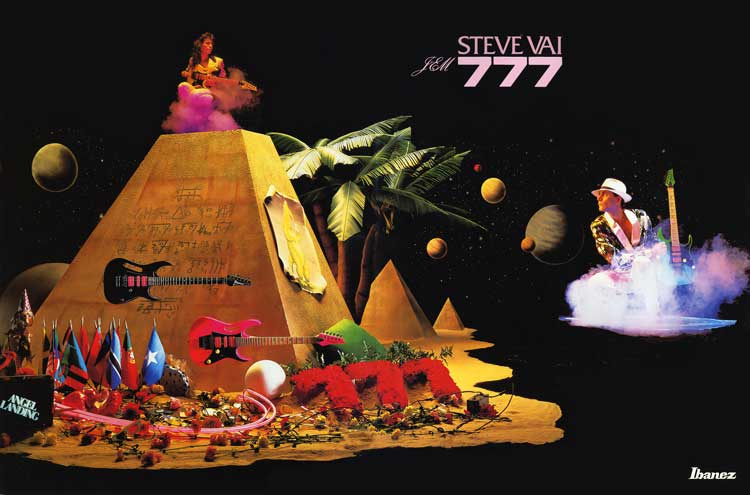
Vai wanted easy access to guitars that met his needs when he was on the road or in the studio. Right before the ’86 tour with Roth, several of Vai’s guitars were stolen out of a rehearsal space. So Vai was scrambling to find replacements that could meet the demands of touring.
Steve went to Frank Zappa’s favorite custom guitar shop, Performace Guitar, to enlist luthier Kunio “Kenny” Sugai. Vai shared his desired specs with Kunio and comments from his guitar tech Elwood Francis. Kunio returned four guitars that were, in essence, the prototype for the future JEM guitar.
Meanwhile, in 1986, Ibanez realized they were in a losing battle with the guitar-of-the-moment, the superstrat. Kramer guitar was leading the superstrat pack with the help of their endorser Eddie Van Halen. So the top brass at Ibanez made it their goal to find their own Eddie Van Halen to endorse their guitar. The collective thought was Steve Vai was the player to pursue.
In September 1986, Ibanez took their prototype Maxxas guitar to Steve at a gig in New York. Before the band’s soundcheck, Vai plugged the guitar into his amps, upon which the semi-hollow body of the Maxxas fed back like crazy.
Ibanez then thought maybe a solid-body Maxxas might work. So in December of 1986, Ibanez sent the green snakeskin guitar to Vai’s parent’s home and asked them to put it under the tree as a gift for Steve. A day after Christmas, Vai called Ibanez to let them know he appreciated the gift but was looking for replicas of his Performance guitars, so if they could make a guitar like that, they could talk.
So he sent all the competing guitar companies what would seem like a simple task. Here are the specs of the guitar I want made. Whoever builds it the best, I will endorse.
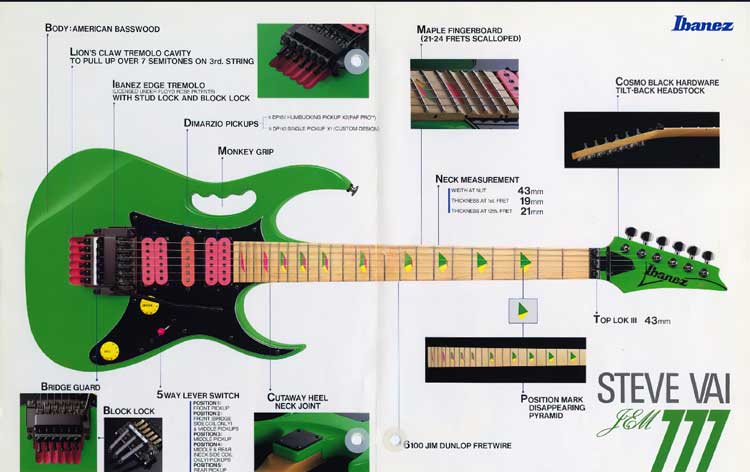
The main things Vai wanted with his guitar were:
- Twenty-four frets compared to the standard 22 and a cut-away body to reach those frets.
- Double humbucker pickups, like Les Pauls, with one single-coil pickup like on Fender Strats with a unique pickup selector that split the coils on the humbuckers.
- Drilled-out area behind the whammy bar so you could pull the note exceptionally sharp, up to a perfect 5th or more based on the setup.
- The monkey grip was added for two main reasons. It would easily make his guitar recognizable, and he wanted to be able to throw the guitars around in videos and concerts while holding the handle.
Vai needed a supply of standardized guitars to his specs so when he was playing he could rely on them staying in tune or when he broke a string and needed to switch guitars they would sound the same.
Ibanez returned to Steve a perfect prototype electric guitar based on his exact specs and Steve entered an endorsement deal with Ibanez.
In June 1987 at the annual National Association of Music Merchants (NAMM) industry trade show, the Ibanez JEM guitar was introduced to the world. (Vai named it JEM in the hopes of attracting some business for Despagni’s guitar company of the same name.) Since then, the JEM has gone on to be one of the most famous, best selling, and longest-running signature series guitars in the history of the instrument and was one of Vai’s smartest business decisions.
Ibanez also released a lower-end guitar based on the Jem, but without the Monkey grip and some other features. This guitar was called the RG, and has gone on to be the best-selling metal guitar in history. Vai has stated the money he made from the JEM deal financially dwarfs any and all other endeavors.
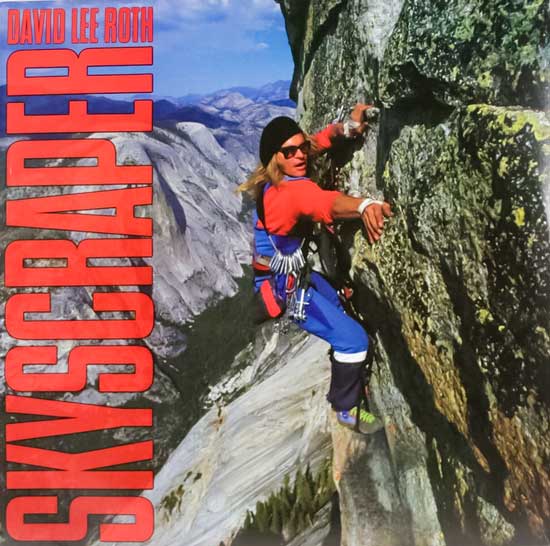
Skyscraper:
By springtime 1987, it was time to start writing and recording the follow-up to the hit album Eat ‘Em and Smile. This time there would be many personnel changes from the previous recording. Instead of Ted Templeman in the producer chair, it would be Roth and Vai. Instead of recording the songs live as a band, they would be pieced together in a more highly produced way. The band members were called in to do their parts as individuals. And maybe the biggest factor was the addition of keyboardist Bret Tuggle. (Tuggle had been on the tour for Eat ‘Em and Smile.)
The rumor was that someone in management had Dave’s ear and convinced him that he should tone down the rawness of Eat ‘Em and Smile and instead try to capitalize on the current wave of dance music in the late ‘80s. The thought was if they could mix a bit of rock with dance, maybe they could transcend Roth to another level. (They even made a 12-inch remix version of “Stand Up” and serviced it to club DJs.) It was ironic that part of the reason Roth left Van Halen was because of Eddie wanting to add more keyboards, but to Roth’s credit, he was trying to push the boundaries of his music to bring in new fans.
The first one to leave the nest was Sheehan. After his bass parts were replaced with keyboards on the title track, “Skyscraper,” he knew it was time to go. He exited right before the album was to be released and was replaced for the tour with Gregg’s brother Matt Bissonette.
Although Skyscraper went on to sell a few million records, some fans thought it paled compared to the brilliant rawness of Eat’ Em and Smile.
But Skyscraper did have a minor hit with the song Just like Paradise, topping out at number 6 on the Billboard Hot 100 and number four on the Billboard Singles chart. Unfortunately, due to a management misstep, co-writers Roth and Brett Tuggle, and co-producer Vai, missed out on a small passive income fortune.
In his book, Crazy from the Heat, Roth tells the story that the producers of the show 90210 wanted to use the song Just Like Paradise for its theme song. But Roth’s manager felt the offer was too low, so he didn’t even mention it to him.
You can imagine how much money was left on the table since Beverly Hills 90210 would go into syndication with ten seasons and almost 300 episodes.
Before the Skyscraper tour, Steve knew it would be his last work with Roth as Vai’s musical desires were changing. At the end of the tour Steve handed in his resignation. By December 1988, he was ready to get to his own solo work. It should be noted that Steve and Billy both praise Roth for all that they learned from him and to this day consider him a friend.
All the time that Steve was navigating Alcatrazz, Crossroads, and the David Lee Roth band, he knew there was a brand of unique music in him that didn’t necessarily fit into any of the bands or situations that he was in prior. He even started chipping away at this music before working with Alcatrazz or Dave Roth.
Whitesnake:
In January of 1989, an additional roadblock slash opportunity came along to Steve that would delay his solo record a little longer. Another legendary band found themselves in need of an A-list guitar player. Whitesnake was in the studio recording the follow-up to their previous self-titled album that had sold over 10 million copies. At the time, the band was on top of the heavy metal food chain.
Whitesnake guitarist Adrian Vanderberg was having a wrist issue that prevented him from playing. (Later it was found that this was the result of a car accident he’d been in years earlier.) Whitesnake founder and singer David Coverdale and Vanderberg had seen Vai in Crossroads and felt he would be the best fit to come in and record for the album.
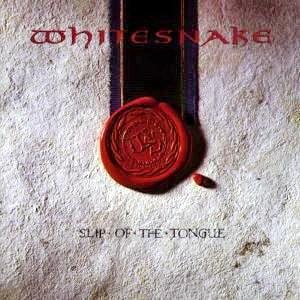
Vai, always the smart musician and businessman, could see that not only was the band filled with talented good-natured musicians, but this would be an opportunity to also raise awareness for his upcoming solo record. So, one month after leaving the tour with Roth, Steve Vai was officially in Whitesnake.
The album, Slip of the Tongue, had already been written and the basic tracks recorded. Here is what Vai said about it: “Adrian had made these guide tracks that were basically chords and structures, and I obviously copped a lot of the riffs from those, but I put my spin on them because it was all like one track of guitar. I went in with 20 tracks on some songs; it’s a very dense guitar record, and I definitely did my best to decorate it! It was a departure for what Whitesnake was normally known for in the guitar department.”
During the recording of the album, Vai brought in the first prototype of the Ibanez Universe seven-string. Slip of the Tongue was the first rock record to use a 7-string guitar throughout. The low-end sound he got from the guitar would later be the hallmark tone for bands like Korn, and the entire genre of Djent can be traced back to Vai’s 7-string Ibanez being the first mass-produced guitar of this type.
Looking back on his time with Whitesnake, Vai said, “It ticked all the right boxes for me because I didn’t have to front the band, I had the greatest lead singer in the world at the time, and I was treated like a king. The guys in the band were just fantastic, and they were gentlemen. Rudy Sarzo is the nicest guy in the world. Tommy Aldridge is hilarious and gifted. Adrian Vandenberg was fantastic; very cultured, liked good things, killer player with good tone! And they all tolerated my attitude and pretension brilliantly. To this day, I remain very happy with the record itself, and I think it stands up as a great-sounding record, even if it may be a little different from the rest of the Whitesnake albums.”